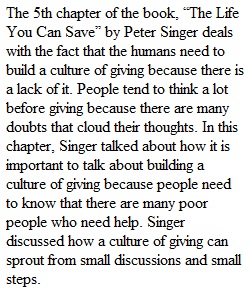


Q Directions 1. Read The Life You Can Save (Links to an external site.) Chapters 5 & 6. 2. Write a 1 page double-spaced summary of these chapters; organize it however you want, as long as you cover the main points of all chapters. 3. This is a summary, not a persuasive essay, so you do not need a thesis. However, every summary should mention the title and author of the book at the beginning so readers know your subject. Use sample reading summary as a guideline. 4. You can reflect on your opinions about the book and the author's ideas, but make sure you first adequately summarize the author's points in your own words. The summary should be at least 80% summary and no more than 20% personal opinion. Don't overthink this assignment; its main goal is to show me you read the material. Summarize in your own words, so no need to add any citations. Grading Requirements • The assignment includes a summary/reflection and MLA format criteria related to the assignment. See the rubric below. Learning Outcomes • Summarize main ideas of chapters • Assess and evaluate main ideas Need Help? If so, please review the following Canvas Guide pages and MLA Format videos: • How do I submit an online assignment? • How do I upload a file as an assignment submission in Canvas? • Canvas Student Guide - Assignments • How do I use the Word MLA format template? (Links to an external site.) • How do I use the Google MLA format template? (Links to an external site.) ________________________________________ Click Next to go to the next page Rubric Rubric: Summary Rubric: Summary Criteria Ratings Pts This criterion is linked to a Learning OutcomeSummary 5 pts Meeting Summary includes a sentence that “hooks” your reader; state the author and title of the reading; summarize what the author said (say what the reading is about); compress all the author’s ideas into just a few sentences; only one paragraph is required; reflection on your thoughts about the piece (as it powerful? Boring? Useful? Not useful? Can you relate to it? How? Etc.). 2.5 pts Approaching Summary includes some of the following: a sentence that “hooks” your reader; state the author and title of the reading; summarize what the author said (say what the reading is about); compress all the author’s ideas into just a few sentences; only one paragraph is required; reflection on your thoughts about the piece (as it powerful? Boring? Useful? Not useful? Can you relate to it? How? Etc.). 0 pts Not Meeting Summary does not include a sentence that “hooks” your reader; state the author and title of the reading; summarize what the author said (say what the reading is about); compress all the author’s ideas into just a few sentences; only one paragraph is required; reflection on your thoughts about the piece (as it powerful? Boring? Useful? Not useful? Can you relate to it? How? Etc.). 5 pts This criterion is linked to a Learning OutcomeMLA Format 5 pts Meeting Doc has all components of MLA - Times New Roman 12-pt. font; double-spaced; 1" margins; header; heading; title; tab indent for first sentence of each paragraph. 2.5 pts Approaching Word or Google Doc has most components of MLA - Times New Roman 12-pt. font; double-spaced; 1" margins; header; heading; title; tab indent for first sentence of each paragraph. 0 pts Not Meeting Doc missing most components of MLA - Times New Roman 12-pt. font; double-spaced; 1" margins; header; heading; title; tab indent for first sentence of each paragraph. 5 pts Total Points: 10
View Related Questions